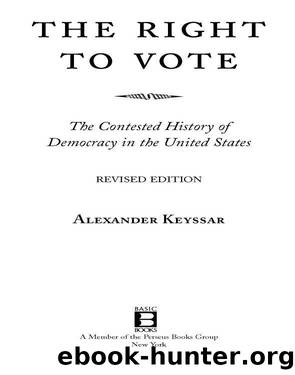The Right to Vote by Alexander Keyssar

Author:Alexander Keyssar
Language: eng
Format: epub
Publisher: Basic Books
The Civil Rights Commission thus lent its prestige and authority to calls for further federal action and the de facto, if not de jure, nationalization of the right to vote. Whether such calls would be heeded depended on a complex political calculus. Both parties were engaged in balancing acts, trying to court northern black and southern white voters simultaneously; for the Democrats this also was a tension between the two regional wings of their own party. Election returns of the 1950s made clear, however, that the balance was unstable and could not continue for long. The rapidly growing black electorate had become influential in many northern states, and black voters, although tending to vote Democratic, could be wooed by pro-civil rights candidates from either party. Eisenhowerâs victories in some southern states, moreover, indicated that single-party dominance in that region was cracking. An additional ingredient in the calculus was the likelihood that black voters would be enfranchised in the South in the foreseeable future and would be unsympathetic to any party that had opposed their enfranchisement. The Civil Rights Acts of 1957 and 1960 were bipartisan compromises constructed to appease competing political interests, but it was apparent that difficult choices loomed on the horizon.7
The pace of governmental activity began to quicken in 1960, largely because the political temperature was soaring in the South. A sit-in at a segregated luncheon counter in Greensboro, North Carolina, sparked a wave of civil disobedience by young African Americans who refused to adhere to the strictures of Jim Crow; freedom riders rode buses to try to integrate interstate transportation; in Birmingham and other cities, mass movements challenged segregation and disfranchisement; efforts to register black voters even reached into the Deep South bastions of white supremacy in rural Alabama and Mississippi. In the latter state, in 1963, eighty thousand African Americans, echoing a strategy from the Dorr War in 1840s Rhode Island, participated in a mock gubernatorial election.8
The growing militance of the black freedom movement only stiffened the opposition. The governors of Alabama and Mississippi refused to desegregate their universities; voting districts were gerrymandered to dilute the influence of blacks who did manage to register; freedom riders were beaten and their buses burned; police arrested protestors by the thousands; bombs were tossed into black churches; and activists were occasionallyâas in Mississippi in 1964âmurdered in cold blood. In 1961, the CCR (whose life had been extended by the 1960 legislation) reported that âin some 100 counties in eight Southern States,â discriminatory laws, arbitrary registration rulings, and threats of âphysical violence or economic reprisalâ still kept most âNegro citizens . . . from exercising the right to vote.â9
The commission also concluded that the federal governmentâs reliance on county-by-county litigation was too âtime consuming, expensive, and difficultâ to bring an end to discriminatory voting practices. âBroader measures are required,â the CCR intoned, urging Congress once again to pass legislation âproviding that all citizens of the United States shall have a right to vote in Federal or State electionsâ if they could meet reasonable age and residency requirements and had not been convicted of a felony.
Download
This site does not store any files on its server. We only index and link to content provided by other sites. Please contact the content providers to delete copyright contents if any and email us, we'll remove relevant links or contents immediately.
| Anthropology | Archaeology |
| Philosophy | Politics & Government |
| Social Sciences | Sociology |
| Women's Studies |
The Secret History by Donna Tartt(16627)
The Social Justice Warrior Handbook by Lisa De Pasquale(11489)
Thirteen Reasons Why by Jay Asher(7788)
This Is How You Lose Her by Junot Diaz(5775)
Weapons of Math Destruction by Cathy O'Neil(5038)
Zero to One by Peter Thiel(4824)
The Myth of the Strong Leader by Archie Brown(4789)
Promise Me, Dad by Joe Biden(4449)
Beartown by Fredrik Backman(4420)
Stone's Rules by Roger Stone(4417)
How Democracies Die by Steven Levitsky & Daniel Ziblatt(4399)
The Fire Next Time by James Baldwin(4343)
100 Deadly Skills by Clint Emerson(4079)
A Higher Loyalty: Truth, Lies, and Leadership by James Comey(4033)
Rise and Kill First by Ronen Bergman(4012)
The David Icke Guide to the Global Conspiracy (and how to end it) by David Icke(3883)
The Farm by Tom Rob Smith(3872)
Secrecy World by Jake Bernstein(3783)
The Doomsday Machine by Daniel Ellsberg(3732)
